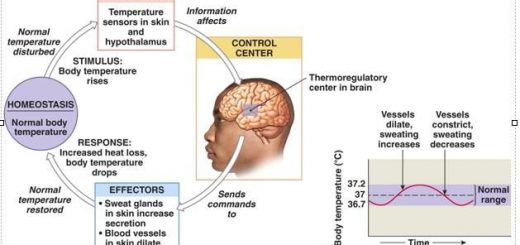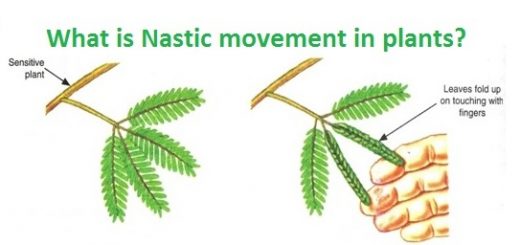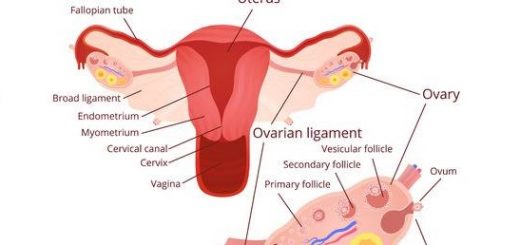Nervous system in man, Nerve cells types and Nature of nerve impulse
The nervous system is highly developed in vertebrates, especially in man, The nervous system and the endocrine glands work together to control all the functions of human body systems, They receive the information in the form of external and internal stimuli through receptor systems, and then give the proper response.
Nervous system in man
This is for keeping the human body in a continuous direct communication with his external and internal environment and for keeping the internal conditions of body in an ideal, constant and balanced state (homeostasis).
The nervous system is divided into:
- Central nervous system (CNS): It includes the brain and spinal cord.
- Peripheral nervous system (PNS): It includes the cranial nerves and spinal nerves.
- Autonomic nervous system : It includes the nerves that control the involuntary muscles and the glands.
Autonomic nervous system is subdivided into Sympathetic nervous system and Parasympathetic nervous system.
Nerve cell
Nerve cell (Neuron) is the structural unit of the nervous system, The Nerve cell is small in size and can’t be recognized by the naked eye, The Nerve cell consists of cell body and cell processes.
Cell body
The cell body of the nerve cell contains a rounded nucleus, Cytoplasm surrounded the nucleus and known as neuroplasm which contains neurofilaments , all cell organelles as mitochondria, and Golgi bodies , except the centrioles, so, neurons can not divide nissil’s granules.
Nissil’s granules are minute granules unique for the nerve cells and they are considered as the stored food for the nerve cell which consumes during its activity .
Cell processes
Cell processes: There are two types of them in the nerve cell, which are:
- Dendrites: many short processes arise from the cell body to increase the surface area to receive the nerve impulses and through which all the nerve impulses enter to the cell.
- Axon (Nerve fiber): It is a long cytoplasmic extension of the cell (may reach more than a meter in length).
It is surrounded by two sheaths:
- Myelin sheath: a sheath of lipid in some nerve cells that is secreted by special cells called schwann cells, Myelin sheath is not continuous around the axon, but it is interrupted at certain points by nodes of Ranvier, Ranvier’s nodes are interruptions at certain points in the myelin sheath on the axon which lack of myelin.
- Neurolemma (Nerve sheath): a thin layer that represents the outer cover of the axon, It ends in a group of branches called terminal arborizations .
Function of the axon: The conduction of nerve impulses from the body of the nerve cell to the synapse, The conduction of nerve impulses in myelinated axons ( covered by myelin sheath ) is much more rapid than in non-myelinated nerve fibers (axons) because the myelin sheath acts as an insulator.
The nerve impulse is propagated and conducted through the nerve cell in one direction only, as the nerve impulses enter the nerve cell body through the dendrites, then to the axon, while the terminal arborizations transmit these impulses away from the cell body (to the next neuron) through the synapse.
Types of nerve cells
According to the function, nerve cells are classified into three types
- Sensory neurons transmit impulses from the receptors to the central nervous system.
- Motor neurons transmit impulses from the central nervous system to the effector organs as muscles and glands.
- Connector (Intermediate) neurons relay impulses from the sensory to the motor neurons (connect between them).
In addition to the cell body and the processes of nerve cells, there is another type of cells in the nervous system known as neuroglia.
Neuroglia (Glial cells)
Another type of cells in the nervous system, can divide and perform the following functions:
- Act as a connective tissue to support the neurons.
- Act as insulators between the neurons.
- Nutrition of neurons.
- Have a role in repairing the injured parts of some neurons.
- Connect the nerve fibers (axons) together to form the nerve bundles which form the nerve.
Nerve
Nerve consists of:
- A group of nerve bundles: Each group is formed a group of nerve fibers (axons) and connected by supporting neuroglial cells.
- Connective tissue sheath surrounds each nerve bundle.
- Epineurium is a connective tissue that surrounds the whole nerve and contains blood vessels.
Nerve impulse
Nerve impulse is the message that is transmitted through the nerves from the sense organs (receptors) to the central nervous system , then to the effector (responding) organs.
Nature of the nerve impulse:
The nerve impulse is an electrical phenomenon with a chemical nature (electrochemical phenomenon), To understand the nature of nerve impulse and its transmission, we have to study the nerve cell during four different conditions.
- The nerve cell at rest.
- The changes in the nerve cell on stimulation.
- Propagation of the nerve impulse through the nerve fibers.
- The return of nerve cell to its original stat.
Nerve cell at rest
At rest, there is a difference in the distribution and concentration of ions outside and inside the nerve cell, as follows:
The concentration of sodium ions (Na+) outside the cell is 10:15 times higher than inside, The concentration of potassium (K+) inside the cell is 30 times higher than outside.
The concentration of negative ions inside the cell is higher than outside, due to the presence of chloride (Cl‾) and protein ions, The amount of negative ions inside the cell exceeds the positive ions, so, the inner surface of the cell carries negative charges.
The amount of positive ions outside the cell exceeds the negative ions, so, the outer surface of the cell carries positive charges, The unequal distribution of ions results in the presence of an electrical potential difference between outside and inside the cell surface, equals (-70 millivolt (m V)).
This potential difference called resting potential, The membrane of nerve cell during this resting condition is said to be polarized and this case is called polarization, Polarization is the state of nerve cell at rest when its outer surface is positive and the inner surface is negative.
The state of polarization is a result of:
- The selective permeability of resting membrane: the membrane of nerve cell is 40 times permeable to K+ ions (which diffuse from inside to outside) than to Na+ ions (which diffuse from outside to inside), This results in the accumulation of excess positive charges on the outer surface membrane.
- The accumulation of high molecular weight protein ions in addition to chloride ions: They are negatively charged on the inner surface of the membrane.
- Sodium-potassium pump: it plays a role in maintaining this ionic distribution.
Therefore, at rest, there is an accumulation of positive K+ ions outside the membrane and negative protein (which can’t pass through the membrane due to its large size) and chloride (Cl‾) ions inside the membrane, and so the potential difference of cell at rest equals (- 70 mV).
The changes in the nerve cell on stimulation
The nerve cell is stimulated only when the stimulus is sufficient, There are changes in the permeability of the membrane in which the inflow of positive sodium ions (Na+) exceeds the outflow of potassium ions (K+) through special channels in the membrane.
This leads to the accumulation of excess positive charges inside the membrane, i.e reverse the original polarity, The membrane potential becomes (+ 40 mV) and this new state is called depolarization, Depolarization is the state of nerve cell on stimulation when its outer surface is negative and the inner surface is positive.
Propagation of the nerve impulse through the nerve fibers
The depolarized point acts as a stimulus for the neighbouring points which undergo the same previous changes as the first time and the process is repeated along the nerve fiber, The nerve impulse is propagated along the nerve fiber in the form of waves of depolarization, polarization and then depolarization again.
Return of the nerve cell to its original state (Repolarization)
After the end of depolarization:
- The membrane becomes again permeable to potassium ions and impermeable to sodium ions.
- The continuous outflow of potassium ions leads again to the accumulation of excess positive ions outside the membrane and the membrane becomes repolarized, and returns to the resting state (- 70 mV).
- The occurrence of the refractory period in which the membrane of a nerve cell regains its physiological properties to be ready to respond to a new stimulus and transmit another nerve impulse.
- The response of nerve cells to the stimulus is called the action potential which includes a state of depolarization followed by repolarization and it equals (110 mV).
- The nerve impulse is the propagation of action potential along the nerve cell (fiber).
The refractory period is the short period (0.001: 0.003 seconds) following the stimulation in which the nerve cell will not respond to any stimulus whatever its strength, During this period the membrane of nerve cell regions its physiological properties (its ability to select permeability) to be ready to respond to new stimulus and transmit another nerve impulse.
The action potential is a potential that includes a state of depolarization (from -70 mV to + 40 mV) followed by repolarization (- 70 mV) and it equals (110 mV).
Properties of the nerve impulse
Speed of the nerve impulse: The speed of propagation of the nerve impulse along a nerve fiber depends on its diameter, as it reaches 140 m/s in thick (myelinated) nerve fibers, while the speed is 12 m/s in thin (non-myelinated) nerve fibers.
All or none law: The stimulation of nerve and muscle obeys the “all or none” law, which states that the nerve responds with maximal strength or with none at all, the sufficient stimulus produces a maximum response (generation of nerve impulse), Any increases in the strength of stimulus will not increase the response, The week stimuli are insufficient to produce an action potential (nerve impulse).
Synapse
Synapse is the site between the terminal branches (arborizations) of the axon of one neuron and the dendrites of the next neuron.
Types of Synapse
- The synapse between two neurons.
- Synapse between a neuron and a muscle fiber.
- The synapse between a neuron and a gland cells.
Structure of Synapse
The ultrastructure of the synapse reveals that the synapse consists of:
- Buttons (Synapatic knobs): swellings at the end of terminal arborizations of an axon and they are very close to the dendrites of the next neuron.
- Synaptic cleft: narrow space separates the presynaptic membrane (axon) from the postsynaptic membrane (dendrite).
- Synaptic vesicles: small sacs filled with chemical transmitters (neurotransmitters) such as acetylcholine and noradrenaline which play an important role in the synaptic transmission of nerve impulses from one neuron to the next.
A chemical transmitter (Neurotransmitter) is a chemical substance that has a role in nerve impulse transmission.
Mechanism of transmitting the nerve impulse across a synapse
The arrival of a nerve impulse to the buttons leads to the entrance of calcium ions by the action of the calcium pump in the cell membrane, The inflow of calcium ions leads to the rupture of synaptic vesicles and the release of chemical transmitters.
The chemical transmitters cross the synaptic cleft and reach the membrane of dendrites of the next neuron, The binding of chemical transmitters to special receptors on the membrane of dendrites leads to the stimulation of these points and changes the permeability of their membrane to Na+ and K+ ions.
This results in depolarization and production of an action potential (nerve impulse), This nerve impulse is propagated through the cell body and moves toward the axon of the neuron, then to the next synapse, and so on.
After performing its function, acetylcholine (chemical transmitter) is destroyed under the effect of an enzyme called cholinesterase to terminate its action, After that, the postsynaptic membrane (dendrite) returns to the resting state again.
Autonomic nervous system, Reflex action types and Autonomic ganglia function
Nervous system (Central nervous system, Peripheral nervous system and Autonomic nervous system)
Functions of Sympathetic nervous system and Role of the sympathetic in emergencies



